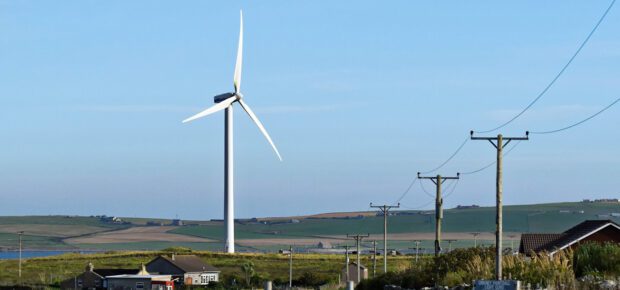December 22, 2022
According to the Pew Research Center, rooftop solar grew 34% between 2020 and 2022. Growth in new installations continues to set new records every quarter.
And by using large scale wind farms,Texas shaved approximately $7.4 billion from wholesale electricity costs in the first eight months of 2022, proving wind technology to be an extremely cost effective form of renewable energy.
But why hasn’t wind power been deployed on rooftops in the same way solar has?
The answer comes down – mostly – to economics.
In most cases, a rooftop solar array would cost more money than a rooftop wind installation for the same capacity. But because wind power is more variable, the solar array generates much more electricity – and operates closer to capacity, making solar the better value.
One case study from Iraq illustrates the tradeoffs: A 3KW solar array cost about twice as much as a 3KW wind system. But the solar system provided about 84% of its maximum capacity in June, and 76% of its capacity in November. Meanwhile, the wind system provided approximately 55% and 43% over the same time period.
That capacity factor is one reason why developers of large wind farms rely on extensive meteorological studies to identify the windiest places.
The cost of photovoltaic (PV) solar panels has dropped dramatically over the past few years, making small scale arrays less expensive. The International Renewable Energy Agency found that the cost of utility scale solar PV projects declined by 88% between 2010 and 2021.
Limitations of Wind Power
Wind power, however, has other challenges. Wind tends to blow harder, the higher you go. At first glance, that might seem to offer an advantage to rooftop wind, but most buildings simply aren’t tall enough. And wind turbines usually need to be pretty big.
The other challenges: wind turbines can be noisy and cause vibrations. The movement of the blades themselves in sunlight creates alternating shadows and light, which leads to a flicker effect.
Still, researchers continue to explore the viability of small scale wind turbines, examining different designs, location techniques, and contexts.
They may be more appropriate in developing nations, for example, and even in some urban locations, according to IEEE Member Rafael Muniz.
“It would be necessary to carry out a study with its own modeling for each urban center, as we often have the formation of so-called wind corridors caused by the architecture of cities,” Muniz said. “This can be a decisive factor in planning the best places for installing wind turbines on roofs.”
Learn more: What is a wind turbine and how does their design impact the amount of power they can generate? Those questions and more are answered in this article.






 Liquid Infrastructure: Our Planet's Most Precious Resource
Liquid Infrastructure: Our Planet's Most Precious Resource The Impact of Technology in 2025
The Impact of Technology in 2025 Quantum and AI: Safeguards or Threats to Cybersecurity?
Quantum and AI: Safeguards or Threats to Cybersecurity? Why AI Can't Live Without Us
Why AI Can't Live Without Us Bits, Bytes, Buildings and Bridges: Digital-Driven Infrastructure
Bits, Bytes, Buildings and Bridges: Digital-Driven Infrastructure Impact of Technology in 2024
Impact of Technology in 2024 Emerging AI Cybersecurity Challenges and Solutions
Emerging AI Cybersecurity Challenges and Solutions The Skies are Unlimited
The Skies are Unlimited Smart Cities 2030: How Tech is Reshaping Urbanscapes
Smart Cities 2030: How Tech is Reshaping Urbanscapes Impact of Technology 2023
Impact of Technology 2023 Cybersecurity for Life-Changing Innovations
Cybersecurity for Life-Changing Innovations Smarter Wearables Healthier Life
Smarter Wearables Healthier Life Infrastructure In Motion
Infrastructure In Motion The Impact of Tech in 2022 and Beyond
The Impact of Tech in 2022 and Beyond Cybersecurity, Technology and Protecting Our World
Cybersecurity, Technology and Protecting Our World How Technology Helps us Understand Our Health and Wellness
How Technology Helps us Understand Our Health and Wellness The Resilience of Humanity
The Resilience of Humanity Harnessing and Sustaining our Natural Resources
Harnessing and Sustaining our Natural Resources Creating Healthy Spaces Through Technology
Creating Healthy Spaces Through Technology Exceptional Infrastructure Challenges, Technology and Humanity
Exceptional Infrastructure Challenges, Technology and Humanity The Global Impact of IEEE's 802 Standards
The Global Impact of IEEE's 802 Standards Scenes of our Cyber Lives: The Security Threats and Technology Solutions Protecting Us
Scenes of our Cyber Lives: The Security Threats and Technology Solutions Protecting Us How Millennial Parents are Embracing Health and Wellness Technologies for Their Generation Alpha Kids
How Millennial Parents are Embracing Health and Wellness Technologies for Their Generation Alpha Kids Space Exploration, Technology and Our Lives
Space Exploration, Technology and Our Lives Global Innovation and the Environment
Global Innovation and the Environment How Technology, Privacy and Security are Changing Each Other (And Us)
How Technology, Privacy and Security are Changing Each Other (And Us) Find us in booth 31506, LVCC South Hall 3 and experience the Technology Moon Walk
Find us in booth 31506, LVCC South Hall 3 and experience the Technology Moon Walk Virtual and Mixed Reality
Virtual and Mixed Reality How Robots are Improving our Health
How Robots are Improving our Health IEEE Experts and the Robots They are Teaching
IEEE Experts and the Robots They are Teaching See how millennial parents around the world see AI impacting the lives of their tech-infused offspring
See how millennial parents around the world see AI impacting the lives of their tech-infused offspring Take the journey from farm to table and learn how IoT will help us reach the rising demand for food production
Take the journey from farm to table and learn how IoT will help us reach the rising demand for food production Watch technical experts discuss the latest cyber threats
Watch technical experts discuss the latest cyber threats Explore how researchers, teachers, explorers, healthcare and medical professionals use immersive technologies
Explore how researchers, teachers, explorers, healthcare and medical professionals use immersive technologies Follow the timeline to see how Generation AI will be impacted by technology
Follow the timeline to see how Generation AI will be impacted by technology Learn how your IoT data can be used by experiencing a day in a connected life
Learn how your IoT data can be used by experiencing a day in a connected life Listen to technical experts discuss the biggest security threats today
Listen to technical experts discuss the biggest security threats today See how tech has influenced and evolved with the Games
See how tech has influenced and evolved with the Games Enter our virtual home to explore the IoT (Internet of Things) technologies
Enter our virtual home to explore the IoT (Internet of Things) technologies Explore an interactive map showcasing exciting innovations in robotics
Explore an interactive map showcasing exciting innovations in robotics Interactively explore A.I. in recent Hollywood movies
Interactively explore A.I. in recent Hollywood movies Get immersed in technologies that will improve patients' lives
Get immersed in technologies that will improve patients' lives